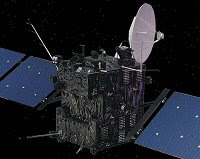 I've been following the development of SpaceX's launcher and spacecraft hardware with great interest. On Monday 7th May, unless there's a further schedule change, the privately owned company will make its first attempt to fly a Dragon spacecraft to dock at the International Space Station (ISS).
I've been following the development of SpaceX's launcher and spacecraft hardware with great interest. On Monday 7th May, unless there's a further schedule change, the privately owned company will make its first attempt to fly a Dragon spacecraft to dock at the International Space Station (ISS).The launcher - Falcon 9 has flown only twice so far, both launches were successful. On its first flight the rocket carried a dummy Dragon to orbit. On the second flight a fully functioning Dragon was orbited and made a successful splashdown and recovery off the Californian coast.
Two successes out of two attempts is a great performance, but tells us almost nothing about levels of reliability. A third success would boost confidence, a failure would be a serious setback.
Falcon 9 (and the smaller Falcon 1) both have commercial orders booked for the satellite launch business. In the case of Falcon 9 those bookings alrready represent a considerable part of the worldwide launch business. If the launcher continues to fly successfully it will quickly become proven as flight frequency ratchets up. At least four further launches are planned in 2012, both for freight delivery to ISS and for commercial customers.
The spacecraft - Dragon has flown once before, this time it needs to repeat the success, navigate to the ISS, and automatically fly to within a few metres of the station. If it manages this, the station's remote manipulator arm will dock it to one of the modules and the ISS astronauts will open it, unload the cargo, and load Dragon with experimental material for return to Earth.
Finally, SpaceX will fly the craft back to splashdown in the Pacific and the capsule and its cargo will be recovered.
A difficult mission - We shouldn't underestimate the difficulties faced by SpaceX. The mission is complex and much of it goes further than the company has ever gone before. It will not be suprising if the mission fails in some or all of its objectives. Nevertheless I think the chances of success are quite good, and I wish SpaceX well with the mission.
What next? - If the flight is a success, NASA has a contract with SpaceX for further cargo flights to the ISS. This would involve two or more flights annually for several years. As mentioned above, there are also contracts with other companies and organisations to fly a variety of other spacecraft. Furthermore, SpaceX is offering commercial Dragon flights (DragonLab) for science and technology payloads for return to Earth.
Expect to see a new version of Dragon for crewed NASA flights to the ISS (or indeed for other organisations). SpaceX is already well along in developing the necessary hardware for this.
And there is a much larger launcher in the pipeline too, Falcon Heavy. This is scheduled for its first test flight later this year, though it may slip to 2013.
For more on SpaceX and their plans see their Google+ page.









